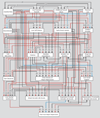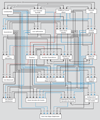Sex differences in the pathways to major depression: a study of opposite-sex twin pairs
- PMID: 24525762
- PMCID: PMC3972260
- DOI: 10.1176/appi.ajp.2013.13101375
Sex differences in the pathways to major depression: a study of opposite-sex twin pairs
Abstract
Objective: The authors sought to clarify the nature of sex differences in the etiologic pathways to major depression.
Method: Retrospective and prospective assessments of 20 developmentally organized risk factors and the occurrence of past-year major depression were conducted at two waves of personal interviews at least 12 months apart in 1,057 opposite-sex dizygotic twin pairs from a population-based register. Analyses were conducted by structural modeling, examining within-pair differences.
Results: Sixty percent of all paths in the best-fit model exhibited sex differences. Eleven of the 20 risk factors differed across sexes in their impact on liability to major depression. Five had a greater impact in women: parental warmth, neuroticism, divorce, social support, and marital satisfaction. Six had a greater impact in men: childhood sexual abuse, conduct disorder, drug abuse, prior history of major depression, and distal and dependent proximal stressful life events. The life event categories responsible for the stronger effect in males were financial, occupational, and legal in nature.
Conclusions: In a co-twin control design, which matches sisters and brothers on genetic and familial-environmental background, personality and failures in interpersonal relationships played a stronger etiologic role in major depression for women than for men. Externalizing psychopathology, prior depression, and specific "instrumental" classes of acute stressors were more important in the etiologic pathway to major depression for men. The results are consistent with previously proposed typologies of major depression that suggest two subtypes that differ in prevalence in women (deficiencies in caring relationships and interpersonal loss) and men (failures to achieve expected goals, with lowered self-worth).
Figures


Comment in
-
Treatment of depression: men and women are different?Am J Psychiatry. 2014 Apr;171(4):384-7. doi: 10.1176/appi.ajp.2013.13121668. Am J Psychiatry. 2014. PMID: 24687191 No abstract available.
References
-
- Kessler RC, McGonagle KA, Swartz M, Blazer DG, Nelson CB. Sex and depression in the National Comorbidity Survey, I: lifetime prevalence, chronicity, and recurrence. J Affect Disord. 1993;29:85–96. - PubMed
-
- Bebbington PE. Sex and depression. Psychol Med. 1998;28:1–8. - PubMed
-
- Kessler RC. Epidemiology of women and depression. J Affect Disord. 2003;74:5–13. - PubMed
-
- Weissman MM, Klerman GL. Sex differences and the epidemiology of depression. Arch Gen Psychiatry. 1977;34:98–111. - PubMed
-
- Weissman MM, Bland RC, Canino GJ, Faravelli C, Greenwald S, Hwu HG, Joyce PR, Karam EG, Lee CK, Lellouch J, Lépine JP, Newman SC, Rubio-Stipec M, Wells JE, Wickramaratne PJ, Wittchen H, Yeh EK. Cross-national epidemiology of major depression and bipolar disorder. JAMA. 1996;276:293–299. - PubMed
Publication types
MeSH terms
Grants and funding
LinkOut - more resources
Full Text Sources
Other Literature Sources
Miscellaneous

